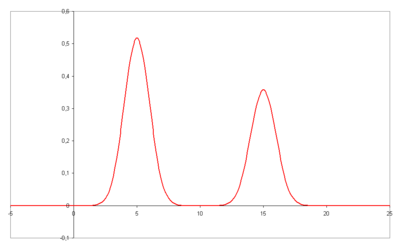- Van Deemter equation
-
The Van Deemter equation in chromatography relates the variance per unit length of a separation column to the linear mobile phase velocity by considering physical, kinetic, and thermodynamic properties of a separation.[1] These properties include pathways within the column, diffusion (axial and longitudinal), and mass transfer kinetics between stationary and mobile phases. In liquid chromatography, the mobile phase velocity is taken as the exit velocity, that is, the ratio of the flow rate in ml/second to the cross-sectional area of the ‘column-exit flow path.’ For a packed column, the cross-sectional area of the column exit flow path is usually taken as 0.6 times the cross-sectional area of the column. Alternatively, the linear velocity can be taken as the ratio of the column length to the dead time. If the mobile phase is a gas, then the pressure correction must be applied. The variance per unit length of the column is taken as the ratio of the column length to the column efficiency in theoretical plates. The Van Deemter equation is a hyperbolic function that predicts that there is an optimum velocity at which there will be the minimum variance per unit column length and, thence, a maximum efficiency. The Van Deemter equation was the result of the first application of rate theory to the chromatography elution process.
Contents
Van Deemter equation
Where
- A = Eddy-diffusion
- B = Longitudinal diffusion
- C = mass transfer kinetics of the analyte between mobile and stationary phase
- u = Linear Velocity.
A is equal to the multiple paths taken by the chemical compound, in open tubular capillaries this term will be zero as there are no multiple paths. The multiple paths occur in packed columns where several routes exist through the column packing, which results in band spreading.
B/u is equal to the longitudinal diffusion of the particles of the compound.
Cu is equal to the equilibration point. In a column, there is an interaction between the mobile and stationary phases, Cu accounts for this.
A minimum value for H can be found by differentiating:
Plate count
The plate height given as:
with
 the column length and :
the column length and : the number of theoretical plates can be estimated from a chromatogram by analysis of the retention time
the number of theoretical plates can be estimated from a chromatogram by analysis of the retention time  for each component and its standard deviation
for each component and its standard deviation  as a measure for peak width, provided that the elution curve represents a Gaussian curve.
as a measure for peak width, provided that the elution curve represents a Gaussian curve.In this case the plate count is given by:[2]
By using the more practical peak width at half height
 the equation is:
the equation is:or with the width at the base of the peak:
Expanded van Deemter
The Van Deemter equation can be further expanded to:
Where:
- H is plate height
- λ is particle shape (with regard to the packing)
- dp is particle diameter
- G, ω, and R are constants
- Dm is the diffusion coefficient of the mobile phase
- dc is the capillary diameter
- df is the film thickness
- Ds is the diffusion coefficient of the stationary phase.
Van Deemter's equation indicates that band broadening mechanisms are proportionally dependent on flow rate, inversely proportional to flow rate and independent of flow rate.
External links
See also
References
- ^ van Deemter JJ, Zuiderweg FJ and Klinkenberg A (1956). "Longitudinal diffusion and resistance to mass transfer as causes of non ideality in chromatography". Chem. Eng. Sc. 5: 271–289. doi:10.1016/0009-2509(56)80003-1.
- ^ IUPAC, Compendium of Chemical Terminology, 2nd ed. (the "Gold Book") (1997). Online corrected version: (2006–) "plate number, N".
Chromatography Techniques Affinity chromatography · Column chromatography · Displacement Chromatography · Electrochromatography · Gas chromatography · High-performance liquid chromatography · Ion chromatography · Micellar electrokinetic chromatography · Normal-phase chromatography · Paper chromatography · Reversed-phase chromatography · Size-exclusion chromatography · Thin-layer chromatography · Two-dimensional chromatographyHyphenated methods Gas chromatography–mass spectrometry · Liquid chromatography–mass spectrometry · Pyrolysis–gas chromatography–mass spectrometryTheory Distribution constant · Freundlich equation · Kovats retention index · Retention factor · Van Deemter equationProminent publications Biomedical Chromatography · Journal of Chromatographic Science · Journal of Chromatography A · Journal of Chromatography B · Journal of Liquid Chromatography & Related Technologies · Journal of Separation ScienceCategories:- Chromatography
- Equations
Wikimedia Foundation. 2010.








